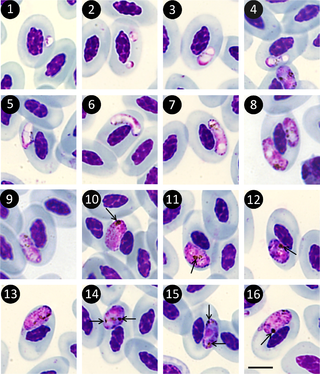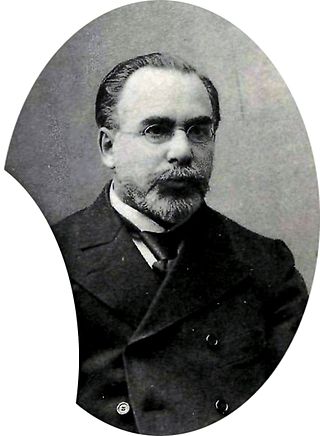
The brown-eared bulbul is a medium-sized bulbul native to eastern Asia. It is extremely common within the northern parts of its range and can be found from southern Karafuto to the northern Philippines.
Plasmodium beebei is a parasite of the genus Plasmodium subgenus Lacertamoeba.

Avian malaria is a parasitic disease of birds, caused by parasite species belonging to the genera Plasmodium and Hemoproteus. The disease is transmitted by a dipteran vector including mosquitoes in the case of Plasmodium parasites and biting midges for Hemoproteus. The range of symptoms and effects of the parasite on its bird hosts is very wide, from asymptomatic cases to drastic population declines due to the disease, as is the case of the Hawaiian honeycreepers. The diversity of parasites is large, as it is estimated that there are approximately as many parasites as there are species of hosts. As research on human malaria parasites became difficult, Dr. Ross studied avian malaria parasites. Co-speciation and host switching events have contributed to the broad range of hosts that these parasites can infect, causing avian malaria to be a widespread global disease, found everywhere except Antarctica.

The Indian golden oriole is a species of oriole found in the Indian subcontinent and Central Asia. The species was formerly considered to be a subspecies of the Eurasian golden oriole, but is now considered a full species. Adults can be told apart from the Eurasian golden oriole by the black of the eye stripe extending behind the eye.
Plasmodium globularis is a parasite of the genus Plasmodium subgenus Novyella. As in all Plasmodium species, P. globularis has both vertebrate and insect hosts. The vertebrate hosts for this parasite are birds.
Plasmodium megaglobularis is a species of malaria-causing parasite in the genus Plasmodium, subgenus Novyella. As in all Plasmodium species, P. megaglobularis has both vertebrate and insect hosts. The vertebrate hosts for this parasite are birds.

Haemoproteus is a genus of alveolates that are parasitic in birds, reptiles, and amphibians. Its name is derived from Greek: haima 'blood' and Proteus, a sea god that had the power to assume various shapes. The name Haemoproteus was first used in the description of H. columbae in the blood of the pigeon Columba livia by Walther Kruse in 1890. This was also the first description of this genus. Two other genera—Halteridium and Simondia—are now considered to be synonyms of Haemoproteus.
Hematozoa is a subclass of blood parasites of the Apicomplexa clade. Well known examples include the Plasmodium spp. which cause malaria in humans and Theileria which causes theileriosis in cattle. A large number of species are known to infect birds and are transmitted by insect vectors. The pattern in which Haematozoa infect a host cell depends on the genera of the blood parasite. Plasmodium and Leucozytozoon displace the nucleus of the host cell so that the parasite can take control of the cell where as Hemoproteus completely envelops the nucleus in a host cell.

The Haemosporida are an order of intraerythrocytic parasitic alveolates.
Polychromophilus is a genus of obligate intracellular eukaryotic parasites that infect bats from every continent except Antarctica. They are transmitted by bat flies, which act as an insect vector as well as the parasite’s site of sporogeny. Polychromophilus follows a fairly typical Haemospororidian lifecycle, with gametocytes and gametes restricted to the bloodstream of the host and meronts infecting organs – most notably the lungs and the liver. The type species is Polychromophilus melanipherus, and was described by Dionisi in 1898.
Haemosporidiasina (Haemosporidia) is a subclass of apicomplexans described by Jacques Euzéby in 1988. The taxon is very similar to Aconoidasida.
Nycteria is a genus of protozoan parasites that belong to the phylum Apicomplexa. It is composed of vector-borne haemosporidian parasites that infect a wide range of mammals such as primates, rodents and bats. Its vertebrate hosts are bats. First described by Garnham and Heisch in 1953, Nycteria is mostly found in bat species where it feeds off the blood of their hosts and causes disease. Within the host, Nycteria develops into peculiar lobulated schizonts in parenchyma cells of the liver, similarly to the stages of Plasmodium falciparum in the liver. The vector of Nycteria has been hard to acquire and identify. Because of this, the life cycle of Nycteria still remains unknown and understudied. It has been suggested that this vector could be an arthropod other than a mosquito or the vector of most haemosporidian parasites.
Haemocystidium is a genus of parasitic alveolates belonging to the phylum Apicomplexia.

The Haemoproteidae are a family of parasitic alveolates in the phylum Apicomplexa.
Haemoproteus columbae is a species of blood parasite related to Plasmodium and other malaria parasites.
Haemoproteus vacuolatus is a parasite. It was found in Andropadus latirostris in Ghana and Cameroon.

Vasily Lakovlevich Danilewsky was a Ukrainian physician, physiologist and parasitologist. He was professor of physiology at University of Kharkiv and then at Kharkiv Medical Institute. He helped to establish the Danilevsky Institute of Endocrine Pathology Problems which he directed until his death.
Haemoproteus homovelans is a parasite first found in the Grey-faced Woodpecker, Picus canus, in Bulgaria. Haemoproteus homovelans has circumnuclear gametocytes that lack volutin granules. The species is similar to Haemoproteus velans, yet the latter's gametocytes are overfilled with volutin.
Haemoproteus coatneyi is a species of parasitic eukaryote that is found in the yellowhammer. Male yellowhammers with high levels of this parasite produced fewer offspring, and tend to be less brightly coloured. The striking plumage of the male yellowhammer may therefore have arisen as a signal of fitness to breed. Yellowhammers infected with Haemoproteus species may have lower winter survival rates due to a tendency to having shorter wings.





